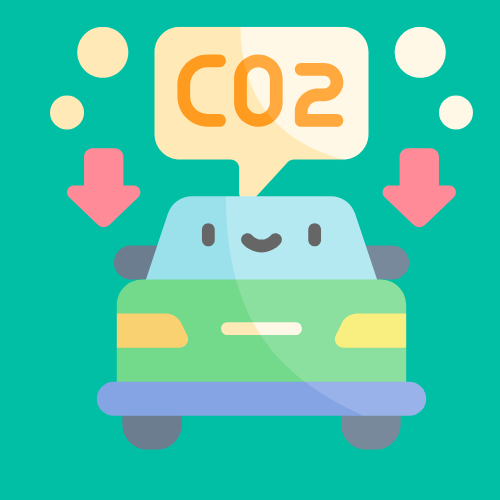10 Eco-Friendly Ways to Lower Your Car’s Emissions
Reducing your car’s emissions is a multi-faceted endeavour that requires a conscious effort on the part of the car owner. However, the payoff is immense, with benefits to both the environment and your pocketbook

As environmental consciousness rises globally, we’re all striving to play our part. For those of us who own cars, this duty brings a unique challenge – how can we continue to use our vehicles while reducing their environmental impact? The answer lies in understanding that small changes can have a profound impact. The following are ten practical ways to lower your car’s emissions, allowing you to contribute positively towards a greener and more sustainable planet.
1. Regular Car Maintenance

Regular maintenance is a fundamental step in ensuring your car’s eco-friendliness. Regular oil changes, tire checks, and engine tune-ups can help your vehicle run more efficiently, thereby reducing the harmful emissions it produces. In fact, according to the U.S. Department of Energy, a well-maintained car can improve its efficiency by up to 4%, significantly reducing its carbon footprint over time.
In addition to regularly maintaining your vehicle, such as checking and replenishing essential fluids, it’s crucial to understand proper disposal methods for used antifreeze. Jenny Chem offers insightful guidance on where antifreeze goes in a car, ensuring environmentally friendly practices in vehicle maintenance
2. Drive Smart
Your driving style significantly affects your car’s emissions. Accelerating rapidly, braking hard, and high-speed driving can increase fuel consumption, leading to higher emissions. Thus, adopting a smoother driving style, keeping a steady pace, and using cruise control when possible can lead to significant reductions in your car’s carbon footprint.
3. Opt for High-Quality Fuel
All fuels are not created equal. Higher-quality fuels, which often include additives, can result in more efficient combustion. This efficiency reduces harmful emissions and improves overall vehicle performance. So, next time you’re at the pump, consider opting for a higher-grade fuel to make your drive more eco-friendly.
4. Reduce Car Weight
Extra weight in your car can drastically increase fuel consumption. Removing unnecessary items, especially heavy ones, can significantly improve your car’s efficiency. So, whether it’s that extra set of golf clubs or the emergency road kit you haven’t used in years, consider offloading anything that isn’t crucial.
5. Utilize Public Transportation or Carpooling

Although not directly related to your car, using public transportation or carpooling can substantially lower your carbon footprint. By sharing rides, we reduce the total number of vehicles on the road, leading to less overall pollution. Furthermore, this option can often be more cost-effective and less stressful.
Before we continue, it’s important to note that while reducing car emissions is a commendable endeavour, unforeseen circumstances can arise on the road. To safeguard against these, be sure to buy car insurance. Not only does it provide financial protection in case of an accident, but many insurance companies also offer incentives for eco-friendly driving habits.
6. Consider a Hybrid or Electric Car
If you’re planning on purchasing a new car, consider a hybrid or electric vehicle. These cars produce significantly less pollution than their traditional counterparts. Electric cars, in particular, produce zero tailpipe emissions and often have lower lifetime emissions than conventional vehicles, even when accounting for their manufacturing and charging processes.
7. Optimize Air Conditioning Use
The use of air conditioning can increase your car’s fuel consumption by up to 20%. To reduce emissions, try to limit the use of air conditioning and instead use the car’s ventilation system. If you do need to use the AC, remember to turn it off once the car is cool.
8. Limit Idling Time
Leaving your car idle, especially for extended periods, leads to unnecessary fuel consumption and increased emissions. If you’re going to be stationary for more than a minute, consider turning off your car’s engine.
9. Plan Your Trips
Bunching up your trips can lead to significant reductions in your car’s emissions. Cold engines use more fuel than warmed ones, so by doing multiple errands in one trip, you reduce the number of times your engine has to warm up.
10. Keep Your Tires Properly Inflated
Properly inflated tires are crucial for eco-friendly driving. Under-inflated tires can cause increased fuel consumption due to higher rolling resistance. By ensuring your tires are at the correct pressure, you can improve your car’s fuel efficiency by up to 3%.
Bonus: Consider Car Sharing as a Sustainable Alternative
Car sharing is an increasingly popular transportation option that aligns perfectly with eco-conscious living. Instead of owning a car that may sit idle for much of the day—still requiring insurance, maintenance, and fuel—car sharing allows you to use a vehicle only when needed, dramatically reducing your environmental footprint.
Shared vehicles are typically newer, well-maintained, and often include hybrid or electric models, which emit fewer pollutants than traditional gas-powered cars. By participating in car sharing, you reduce the total number of vehicles on the road, help decrease traffic congestion, and cut down on the carbon emissions associated with vehicle manufacturing and disposal.
Moreover, car sharing encourages more intentional driving habits. Since users pay per trip or per hour, people are more likely to combine errands, avoid unnecessary trips, and walk or bike when possible. In urban areas across California and beyond, car sharing networks like Zipcar, Getaround, and Turo make it easy to find a car nearby for short-term use—without the long-term environmental impact of car ownership.
If you’re committed to eco-friendly driving but don’t want to fully give up the convenience of a car, car sharing offers the perfect middle ground.
Summary
In conclusion, reducing your car’s emissions is a multi-faceted endeavour that requires a conscious effort on the part of the car owner. However, the payoff is immense, with benefits to both the environment and your pocketbook. As we strive to make our planet more sustainable, every little effort counts. And remember, the journey towards a more eco-friendly lifestyle doesn’t end with these steps – it’s just the beginning.
FAQ
What are the most effective ways to reduce emissions from my car?
Reduce emissions by regularly maintaining your vehicle, using the recommended grade of motor oil, keeping tires properly inflated, reducing idle time, and driving efficiently by avoiding rapid accelerations and heavy braking.
How does carpooling help in lowering car emissions?
Carpooling reduces the number of vehicles on the road, leading to lower overall emissions by sharing rides and decreasing individual fuel consumption and exhaust output.
Can switching to a more fuel-efficient vehicle significantly lower emissions?
Yes, switching to a more fuel-efficient vehicle, such as a hybrid or electric car, can significantly reduce emissions by consuming less fuel or using cleaner energy sources.
What role do alternative fuels play in reducing car emissions?
Alternative fuels like biofuels, electricity, and hydrogen produce fewer emissions than traditional gasoline or diesel, helping to reduce the overall environmental impact of car use.
How does driving speed affect a vehicle’s emissions?
Higher speeds generally increase fuel consumption and emissions. Maintaining a moderate and steady speed can improve fuel efficiency and reduce emissions.
What is the impact of regular vehicle maintenance on emissions?
Regular maintenance, including timely oil changes, air filter replacements, and engine check-ups, keeps the vehicle running efficiently, thus reducing emissions.
How do eco-driving techniques contribute to lower car emissions?
Eco-driving techniques, such as smooth acceleration and deceleration, maintaining a steady speed, and using cruise control, can improve fuel efficiency and reduce emissions.
Can the use of air conditioning in cars affect emissions?
Yes, excessive use of air conditioning can increase fuel consumption and emissions. Using it minimally or at moderate settings can help reduce these effects.
What is the role of tire pressure in vehicle emissions?
Properly inflated tires reduce rolling resistance, improving fuel efficiency and thereby lowering emissions. Regularly checking and maintaining the correct tire pressure is important.
How does reducing vehicle weight contribute to lower emissions?
Reducing vehicle weight, by removing unnecessary items from the car, can improve fuel efficiency as the engine requires less energy to move a lighter vehicle, leading to lower emissions.
How can upgrading a vehicle’s exhaust system impact emissions?
Upgrading to a more efficient exhaust system can improve engine efficiency and reduce emissions. High-quality systems ensure better exhaust flow and more complete fuel combustion.
What are the environmental benefits of using low-sulfur fuel in cars?
Low-sulfur fuel reduces the amount of sulfur dioxide and particulate matter emissions, contributing to cleaner air and less environmental pollution.
Can changing driving habits significantly reduce a car’s emissions?
Yes, changing driving habits like reducing frequent stops and starts, avoiding high speeds, and minimizing idling can lead to significant reductions in a car’s emissions.
How does engine size affect a car’s emissions?
Larger engines typically consume more fuel and produce higher emissions. Opting for a car with a smaller, more efficient engine can help reduce emissions.
What is the impact of stop-start technology on reducing car emissions?
Stop-start technology reduces emissions by shutting off the engine when the car is stationary and restarting it when the accelerator is pressed, decreasing fuel consumption and emissions during idle periods.
How do remote working or telecommuting practices contribute to lowering car emissions?
Remote working reduces the need for commuting, directly decreasing the number of vehicles on the road and the associated emissions from daily travel.
Can regular engine tune-ups help in reducing a vehicle’s emissions?
Regular engine tune-ups ensure that the engine runs efficiently, improving fuel economy and reducing emissions.
What is the role of government regulations in reducing car emissions?
Government regulations play a significant role by setting emission standards for vehicles, promoting the use of cleaner fuels, and encouraging the adoption of low-emission and electric vehicles.
How does route planning help in minimizing car emissions?
Efficient route planning can reduce the distance traveled and time spent in traffic, leading to less fuel consumption and lower emissions.
What are the benefits of electric cars in terms of emissions compared to traditional vehicles?
Electric cars offer significant benefits by producing zero tailpipe emissions, reducing air pollution, and, when charged with renewable energy, contributing to a substantial overall reduction in greenhouse gas emissions.
How do hybrid vehicles contribute to lower car emissions?
Hybrid vehicles combine a gasoline engine with an electric motor, offering better fuel efficiency and lower emissions than traditional combustion engine vehicles, especially in city driving with frequent stops.
What impact does tire choice have on a vehicle’s emissions?
Using low rolling resistance tires can improve a vehicle’s fuel efficiency, leading to reduced emissions, as less energy is needed to keep the vehicle moving.
Can reducing the use of heavy car accessories lower emissions?
Yes, reducing the use of heavy accessories like roof racks, which increase aerodynamic drag, can improve fuel efficiency and lower emissions.
How does the use of public transportation contribute to reducing overall car emissions?
Using public transportation reduces the number of individual vehicles on the road, decreasing traffic congestion and overall emissions from personal vehicle use.
What are the benefits of using a car-sharing service in terms of emissions?
Car-sharing services lead to fewer cars on the road overall, as they promote the efficient use of a single vehicle by multiple people, reducing total emissions per capita.
Can driving in a higher gear reduce a car’s emissions?
Driving in a higher gear at a lower RPM can reduce fuel consumption and emissions, as it requires less fuel to maintain the vehicle’s speed.
What is the significance of emission testing and certification for vehicles?
Emission testing and certification ensure that vehicles meet specific air quality standards, helping to reduce harmful emissions and protect the environment.
How do fuel additives play a role in reducing car emissions?
Certain fuel additives can improve engine efficiency and cleanliness, leading to better fuel combustion and reduced emissions of pollutants.
What impact does car sharing and pooling apps have on vehicle emissions?
Car sharing and pooling apps can significantly reduce emissions by optimizing the number of passengers per vehicle, leading to fewer trips and less overall fuel consumption.
How effective are government incentives in promoting low-emission vehicles?
Government incentives like tax breaks, subsidies, and rebates can be highly effective in promoting the adoption of low-emission vehicles by making them more affordable and attractive to consumers.
Create more and better content
Check out the following resources and Grow!